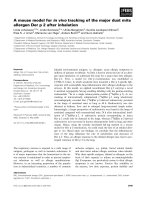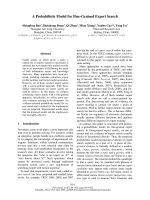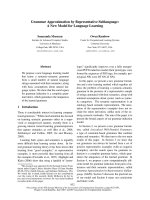A fuzzy model for network intrusion detection
Bạn đang xem bản rút gọn của tài liệu. Xem và tải ngay bản đầy đủ của tài liệu tại đây (191.42 KB, 5 trang )
International Journal of Computer Networks and Communications Security
C
VOL. 2, NO. 5, MAY 2014, 168–172
Available online at: www.ijcncs.org
ISSN 2308-9830
N
C
S
A Fuzzy Model for Network Intrusion Detection
S.Sethuramalingam1 and Dr.E.R.Naganathan2
1
Associate Professor and Head, Department of CS, Aditanar College, Tiruchendur
2
Professor and Head, Department of CSE, Hindustan Univesity, Chennai
E-mail: ,
ABSTRACT
The network intrusion becomes ever growing problem. The complexity present in the collected network
data set is absence of clear boundary between anomaly connection and normal connection. However fuzzy
logic can well address this problem. In earlier works, combining fuzzy logic and data mining to develop
fuzzy rules are explored to address this problem. In this paper, a new fuzzy model is developed to detect
anomaly connections. The developed model is tested with NSLKDD data set. The model gives better result.
Keywords: Network intrusion ,anomaly detection, fuzzy model, 10-fold cross validation.
1
INTRODUCTION
As defined in [1], intrusion detection is “the
process of monitoring the events occurring in a
computer system or network and analyzing them
for signs of intrusions, defined as attempts to
compromise
the
confidentiality,
integrity,
availability, or to bypass the security mechanisms
of a computer or network”.
In a computer network, there are two main
intrusion detection systems - Anomaly intrusion
detection system and misuse intrusion detection
system. The first one is based on the profiles of
normal behaviour of users or applications and
checks whether the system is being used in a
different manner. The second one collects attack
signatures, compares behaviour with the collected
attack signatures and signals intrusion when there is
a match [2].
System
with
characteristics
such
as
impreciseness, vagueness and ambiguity make the
system more complex. If these characteristics can
be represented correctly then the understanding of
complexity will be less. Fuzzy logic is a useful tool
to represent the ambiguity present in the data set.
On other hand the network intrusion data set is
ambiguous and does not have clear boundary
between anomaly and normal connections. In this
work, fuzzy logic is proposed to represent the soft
boundary present in the data set. The fuzzy rule
based system is designed to address this problem [1
3 4]. Earlier the fuzzy rules are created from the
knowledge of domain expert.
Today, with more and more computers getting
connected to public accessible networks (e.g., the
Internet), it is impossible for any computer system
to be claimed immune to network intrusions. Since
there is no perfect solution to prevent intrusions
from happening, it is very important to be able to
detect them at the first moment of occurrence and
take actions to minimize the possible damage.
Before data mining techniques are introduced into
this field, intrusion detection was heavily dependent
on a manually maintained knowledge base which
contained signatures of all known attacks. Features
of monitored network traffic were extracted and
then compared with these attack signatures.
Whenever a match was found, an intrusion was
claimed to be detected and it was reported to the
system administrator. Due to the difficulty and
expense to manually maintain the knowledge base
to reflect the ever changing situations, it was not
feasible to continue working in this traditional way.
Therefore now systems are developed to learn from
the collected data. The remaining part of paper is
organized as section 2 presents Related work
section 3 presents the Proposed algorithm, section 4
169
S. Sethuamalingam and E. Naganathan / International Journal of Computer Networks and Communications Security, 2 (5), May 2014
discusses Experiments and results and section 5
discusses conclusion
2
RELATED WORK
In [5] authors collected profile of the network
and constructed a intrusion detection algorithm. In
[6] the authors proposed to develop dynamic fuzzy
boundary from labeled data. In this work, a
dynamic fuzzy boundary is proposed to detect
anomaly connections. The boundary is developed
using SVM and Fuzzy Logic. In [7] authors
proposed hybrid model based on fuzzy logic and
neural network. In [8] authors developed an
algorithm using Artificial Neural Networks with
fuzzy clustering. In[9][10] the Mamdani fuzzy
model is applied for zooming function for digital
camera and Permeability detection of skin
respectively. In [11] authors discussed about
designing fuzzy controller to detect anomaly based
connections. However exploring fuzzy model to
detect network intrusion is very few. In this paper, a
fuzzy model is proposed to detect anomaly.
3
PROPOSED ALGORITHM
The new version of KDD data set NSL-KDD is
publicly available for researchers through the
website [12] [13] . Although, the data set still
suffers from some of the problems discussed [14]
and may not be a perfect representative of existing
real networks, because of the lack of public data
sets for network-based IDSs, the authors believe
that it still can be applied as an effective benchmark
data set to help researchers compare different
intrusion detection methods.
The NSL-KDD [13] data set has 41 conditional
attributes and one decision attribute. The value of
the decision attribute is either anomaly or normal.
The features service ,flags ,src_bytes, dst_bytes and
dst_host_serror_rate i.e. 5 attributes out of the 41
attributes are used in the algorithm. A collection of
numeric data is standardized by subtracting a
measure of central location such as mean and
divided by some measure of spread such as
standard deviation [14].
3.1 Fuzzy Model
The figure 1 shows the Proposed fuzzy model
which consists of
i.
ii.
iii.
a fuzzifier (encoder);
an inference engine (processor); and
a defuzzifier (decoder).
i.
Fuzzifier
A fuzzifier has the function of converting (or
encoding) input categorical or numeric data (crisp
values) into fuzzy values. Because these values
propagate through a model and ultimately
determine the output, fuzzification is the most
crucial procedure in fuzzy modeling. Fuzzification
of input data always relates to a fuzzy proposition
and is carried out by means of a membership
function which can be derived either from a priori
knowledge of a system or by using input data
Let the connection record contains n attributes.
A1,A2,A3,……An be fuzzy set for anomaly class
attributes 1,2 … and n respectively. N1
,N2,N3,……Nn be fuzzy set for normal class
attributes 1,2 … and n respectively. The
membership values for the attributes are µA1(xi1),
µA2(xi2), …µAj(xij)…….. µAn(xmn) for anomaly
class. The membership values for the attributes are
µN1(xi1), µN2(xi2), …..µNj(xij)…….. µNn(xmn) for
normal class. For each attribute fuzzy membership
function is defined as
(x) =gaussmf(xij,[trn_amean,trn_astd]) where
trn_amean and trn_astd are the mean and standard
deviation of anomaly class respectively.
(x)=gaussmf(xij,[trn_nmean,trn_nstd])
where
trn_nmean and trn_nstd are the mean and standard
deviation of normal class respectively.
Fuzzy
member
ship
function
Input
Fuzzy
infere
nce
rules
defuzzi
fication
output
Figure 1: Architecture of a typical fuzzy model.
ii. Inference engine
An inference engine is the mind of a fuzzy
model. Its function is to filter out informational
noise and create a synthesized fuzzy set from the
individual fuzzy sets transmitted by the fuzzifier. In
the proposed model, The product of membership
value for the ith record for anomaly connection is
computed by the following equation
ayi = ∏
(xij)
The product of membership value for the ith
record for normal connection is computed by the
following equation
nyi=∏
(xij)
now these values are mapped to the following
function
170
S. Sethuamalingam and E. Naganathan / International Journal of Computer Networks and Communications Security, 2 (5), May 2014
f(x) ←(x-x’)/ σ
where x’ and σ are mean and standard deviation
respectively from this equation the value of input
to the function is computed
x= σ*f(x)+x
using the equation the value for x is computed for
anomaly connection as well as for normal
connection.
if i> anolimit
tn←tn+1;
else
fp←fp+1;
end
end
end
A confusion matrix as shown in the Table 1 is
typically used to evaluate the performance of the
algorithm.
iii. Defuzzifier
A defuzzifier transforms the synthesized fuzzy
set back to a crisp set, which expresses the result of
modeling. It can be a mathematical function or a
subjectively- or objectively-defined threshold fuzzy
value. Hellendoorn and Thomas (1993) describe a
number of criteria that an ideal defuzzification
procedure should satisfy. The most important
criterion is that a small change in inputs of a fuzzy
model should not cause a significant change in
output. These xi values are computed and compared
and the given record is assigned to a class which
has maximum xi value.
Algorithm fuzzy_compos( trn_amean, trn_astd,
trn_nmean, trn_nstd, tstdataset)
Tstdataset: testing data set has m records and n
attributes
Trn_amean: mean of anomaly class records in the
training data set
Trn_astd: standard deviation of anomaly class
records for the training data set
Trn_nmean: mean of normal class records in the
testing data set
Trn_nstd: standard deviation of normal class
records in the testing data set
for each connection record in the testing data set
py1←1
py2←2
for each attribute in the connection record
y(i,j)←gausmf(x(i,j),[trn_amean,trn_astd])
y1(i,j)←gausmf(x(i,j),[trn_nmean,trn_nstd])
py1←py1*y(i,j)
py2←py2*y1(I,j)
end
by1(i)←py1;
by2(i)←py2;
end
for each connection record in the testing data set
f1(i) ←(by1(i)*trn_astd)+trn_amean;
f2(i) ←(by2(i)*trn_nstd)+trn_nmean;
if (f1(i)>f2(i))
if i <= anolimit
tp←tp+1;
else
fn←fn+1;
end
Table. 1. Standard metrics for evaluation of intrusions
Confusion Matrix
(standard metrics)
Predicted connection
label
Normal
Intrusion
(Anomaly)
Actual
connection
Label
True
Negative
(TN)
False
Negative
(FN)
normal
Intrusion
(anomaly)
False
Alarm (FP)
Correctly
detected
(TP)
From Table 1, recall and precision may be
defined as follows
Precision=TP/(TP+FP)
Recall=TP/(TP+FN)
4
RESULTS AND DISCUSSION
In the proposed work, there are only two fuzzy
values (f1(i) and f2(i)) are used to detect whether
the given connection belongs to anomaly or normal
for the training data set, the value of the parameters
of fuzzy membership functions, mean and standard
deviation are computed. Using these parameters,
the fuzzy membership for each attribute in the
connection record is computed for testing data set.
For each connection record there are two set of
member functions are assigned corresponding to
the two classes. Product of membership value for
each record is computed by multiplying their
attribute membership value. These product values
are mapped to a output function. Now the values of
output function are compared. The given
connection record is assigned a class for which the
function has maximum value.
In 10-fold cross-validation, the original sample is
randomly partitioned into 10 subsamples. Of the 10
subsamples, a single subsample is retained as the
validation data for testing the model, and the
remaining 9 subsamples are used as training data.
The cross-validation process is then repeated 10
times (the folds), with each of the 10 subsamples
171
S. Sethuamalingam and E. Naganathan / International Journal of Computer Networks and Communications Security, 2 (5), May 2014
used exactly once as the validation data. The 10
results from the folds then can be averaged (or
otherwise combined) to produce a single
estimation. The advantage of this method over
repeated random sub-sampling is that all
observations are used for both training and
validation, and each observation is used for
validation exactly once [15].
The algorithm is compared with another algorithm
that uses correlation to match testing data with
training data set in the inference process. The class
which has maximum correlation is assigned to that
record. Table 2 and Table 3 show the result of the
algorithms respectively.
Table. 2. Algorithm using mapping to the function
Run
anomaly
normal
total
470
529
999
470
529
999
470
529
999
470
529
999
470
529
999
470
529
999
470
529
999
470
529
999
470
529
999
470
529
999
1
2
3
4
5
6
7
8
9
10
fp
4
0
4
7
5
5
5
2
5
0
4
8
4
2
4
8
6
0
4
3
Precision
=
tp/(tp+fp
)
Recall=
tp/(tp+fn)
fn
tp
tn
80
10
3
390
489
0.9069
0.8297
367
482
0.8864
0.7808
92
378
474
0.8729
0.8042
88
382
477
0.8808
0.8127
96
374
479
0.8820
0.7957
97
373
481
0.8859
0.7936
83
387
487
0.9020
0.8234
81
389
481
0.8901
0.8276
85
385
469
0.8651
0.8191
92
378
486
0.8978
0.8042
0.8868
0.8091
average
Table. 3. Algorithm using mapping to the correlation
Run
anomaly
normal
total
1
470
529
Precision
=
tp/(tp+fp)
Recall
=
tp/(tp+fn)
fp
fn
tp
tn
999
36
396
493
0.9166
0.8425
470
529
999
57
74
10
2
368
472
0.8658
0.7829
3
470
529
999
55
83
387
474
0.8755
0.8234
4
470
529
999
57
86
384
472
0.8707
0.8170
5
470
529
999
51
93
377
478
0.8808
0.8021
6
470
529
999
56
88
382
473
0.8721
0.8127
7
470
529
999
48
81
389
481
0.8901
0.8276
8
470
529
999
68
72
398
461
0.8540
0.8468
9
470
529
999
64
77
393
465
0.8599
0.8361
470
529
999
44
96
374
485
0.8947
0.7957
0.8777
0.8187
2
10
average
172
S. Sethuamalingam and E. Naganathan / International Journal of Computer Networks and Communications Security, 2 (5), May 2014
5
CONCLUSION
In this paper, a new fuzzy model is proposed to
detect anomaly connection. A second algorithm is
developed based on correlation in the inference
stage and to test the proposed algorithm. The
precision and recall values are almost same. It
infers that the proposed algorithm works in
expected manner. The impact of the algorithm is
studied with different membership function for the
input as well as mapping the output.
6
REFERENCES
[1] Wang, L. and J.M. Mendel, “Generating Fuzzy
Rules
from
Numerical
Data,
with
Applications”, Technical Report USC-SIPI169, Signal and Image Processing Institute,
University of Southern California, Los
Angeles, CA 90089, 1991.
[2] Fayyad.U.M,
Piatetsky-Shapiro.G,
and
Smyth.P, “From data mining to knowledge
discovery in databases”. AI Magazine, vol. 17,
no. 3, pp. 37.54, 1996
[3] Kosko, B. “Neural Networks and Fuzzy
Systems: A Dynamical Systems Approach to
Machine
Intelligence”,
Prentice
Hall,
Englewood Cliffs, NJ, 1992.
[4] [4]. Sudkamp. T. and R.J. Hammell II,
“Interpolation,Completion,
and
Learning
FLKZY Rules”, IEEE Transactions on
Systems, Man, and Cybernetics, 1994, 24, 2,
pp.332-342.
[5] John E. Dickerson and Julie A. Dickerson
“Fuzzy Network Profiling for Intrusion
Detection”,
Electrical
and
Computer
Engineering Department Iowa State University
Ames, Iowa, 50011
[6] J.T. Yao S.L. Zhao L. V. Saxton “A study on
fuzzy intrusion detection” ,Department of
Computer Science, University of Regina,
Regina Saskatchewan, Canada S4S 0A2
[7] Muna Mhammad T. Jawhar, Monica Mehrotra
“Design Network Intrusion Detection System
using hybrid Fuzzy-Neural Network”, Faculty
of Natural Science Department of computer
science Jamia Millia Islamia ,New Delhi,
110025, India
[8] Gang Wang , Jinxing Hao b, Jian Mab, Lihua
Huang “A new approach to intrusion detection
using Artificial Neural Networks and fuzzy
clustering”, School of Management, Fudan
University, Shanghai 200433, PR China and
Department of Information Systems, City
University of Hong Kong, Tat Chee Avenue,
Kowloon, Hong Kong
[9] I. Elamvazuthi, P. Vasant “The Application of
Mamdani Fuzzy Model for Auto Zoom
Function of a Digital Camera” Universitiy
Technologi PETRONASTronoh, Malaysia
J.Webb University of Technology Swinnburne,
Sarawak Campus,Kuching, Sarawak, Malaysia
[10] Deepak R. Keshwani, David D. Jones,George
E. Meyer and Rhonda M. Brand “IL Rulebased Mamdani-type fuzzy modeling of skin
Permeability”,Feinberg School of Medicine,
Evanston, Biological Systems Engineering 11-2008
[11] Farzaneh
Geramiraz,
Amir
Saman
Memaripour, and Maghsoud Abbaspour
“Adaptive Anomaly-Based Intrusion Detection
System Using Fuzzy Controller” Computer
Engineering Department, Faculty of Electrical
and Computer Engineering, Shahid Beheshti
University, G. C.,Evin, Tehran, Iran.
International Journal of Network Security,
Vol.14, No.6, PP.352-361, Nov. 2012
[12] Mahbod Tavallaee, Ebrahim Bagheri, Wei Lu,
and Ali A. Ghorbani . “A Detailed Analysis of
the KDD CUP 99 Data Set Proceeding of the
IEEE
Symposium
on
Computational
Intelligence in Security and Defence
Applications” (CISDA 09)
[13] />[14] Hai Jin Jianhua Sun, Han Chen, Zongfen Han
“A Fuzzy
Data Mining Based Intrusion
Detection Model”, Cluster and Grid
Computing Lab. Huazhong University of
Science and Technolory, Wuhan 430074
China.. Proc. Of the 10th IEEE International
Workshop on Feature Trends of Distributed
Computing Systems 2004 IEEE
[15] Picard, Richard; Cook, Dennis (1984). "CrossValidation of Regression Models". Journal of
the American Statistical Association 79 (387):
575–583.









